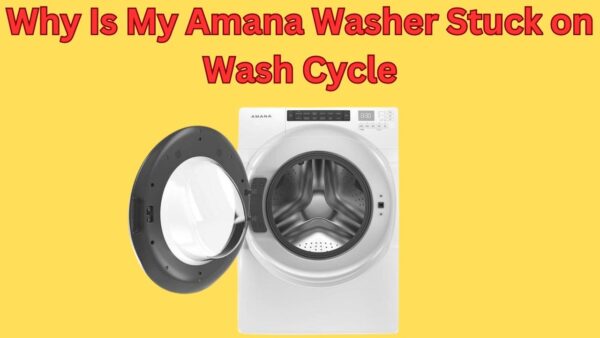Is your Whirlpool washer making strange noises? Don’t worry—you’re not the only one. Many people notice unusual sounds during the sensing cycle, and it’s a common issue. The good news is, most problems have simple solutions that won’t break the bank.
This guide covers 15 reasons your washer might be noisy and how to fix them, whether you handle it yourself or need expert help.
Let’s get your laundry routine back to being peaceful and quiet!
Why does my washer click when sensing?
A clicking noise during the sensing cycle of your washer is often normal. It happens because the machine is testing the load’s weight and balance before starting the wash.
Sometimes, the sound comes from relays switching or the drive motor engaging, which is part of the washer’s design. However, if the clicks are loud or unusual, it might indicate an issue, like debris in the motor or a faulty sensor.
Checking the drum and consulting your washer’s manual can help pinpoint the problem quickly.
Why does my washing machine make a screeching sound when sensing?
A screeching sound during the sensing cycle of your washing machine can’t be ignored—it’s a clear sign something’s wrong. One common cause is a worn-out or damaged drive belt that slips while the machine is checking load weight.
Another possibility is the motor or drum bearings wearing down, creating friction that leads to that unpleasant noise. Sometimes, debris caught between the drum and the tub can also cause screeching as the machine tries to spin.
Lastly, if the noise is coming from the pump or pulley, they may need cleaning or replacement. Checking these components right away can save you from bigger repairs down the line.
Why is my Whirlpool washer making a noise?
A noisy Whirlpool washer can be frustrating, but it’s often a sign of a fixable issue. First, check if there’s an uneven load inside the drum. Large or heavy items bunching up can throw off the balance and create loud banging during the spin cycle.
Next, inspect the washer’s feet to ensure it’s level. An unbalanced machine can vibrate and produce rattling sounds. If you hear squeaks or grinding, the drum bearings or drive belt might be worn and need replacing.
Finally, loose objects like coins or buttons stuck in the drum or pump can cause unexpected clanking. Regular maintenance and keeping an eye out for these problems can keep your washer running smoothly
Whirlpool Washer Making Noise When Sensing Solution List

1. Faulty Drain Pump
Cause
A faulty drain pump is often responsible for a Whirlpool Washer making noise during the sensing phase.
This is typically due to wear and tear from regular use, or potentially from an obstruction that is causing the pump to function improperly.
Continuous operation under these conditions leads to strain on the motor, resulting in unusual noises.
Solution:
The solution involves first checking for any visible obstructions in the drain pump. If none are found, a replacement pump will likely be required.
It’s crucial to replace a faulty drain pump promptly to avoid further damage to the washer.
Moreover, a professional repair specialist should be contacted for assistance to ensure proper fitting and functioning.
Remember, professional help guarantees the longevity and efficiency of your appliance.
2. Broken Tub Bearing
Cause
The tub bearing is subjected to high stress during the washing machine’s operation.
Over time and with continual use, this stress can cause the bearing to wear out, leading to a broken tub bearing.
This may result in a loud noise during the spin cycle, or you may notice a leak underneath your washing machine.
Remember, an unusual noise or leak is often a clear indication of a broken tub bearing.
Solution:
The solution to a broken tub bearing is replacement. Unfortunately, replacing a tub bearing is a complex, labor-intensive task that often requires disassembling most of the washing machine.
It is highly recommended to hire a professional technician to perform this task to avoid causing further damage to the machine.
However, if your machine is old, consider whether it’s more cost-effective to replace the entire machine rather than repair it.
3. Worn Out Drive Pulley
Cause
A worn-out drive pulley is usually the result of prolonged use and inadequate maintenance.
Constant friction and daily wear and tear gradually wear down the part, affecting its ability to effectively transmit power.
This can lead to inefficiencies, decreased performance, and eventually, mechanical failures.
Solution:
The key to resolving this issue lies in regular inspection and timely replacement. Ensure you regularly check the condition of the drive pulley and replace it as soon as wear is detected.
It’s prudent to keep an extra drive pulley on hand to minimize downtime.
Adhering to manufacturer-recommended maintenance schedules also significantly extends the life of the pulley and improves overall performance.
Practicing these measures not only remedies the immediate issue but also prevents potential damage to other interconnected components.
4. Malfunctioning Washer Drive Belt
Cause
A malfunctioning washer drive belt can result from several issues, most notably from natural wear and tear, improper alignment, or excessive load.
Over time, the belt can lose its elasticity, leading to operational inefficiency.
Furthermore, if the belt isn’t properly aligned with the pulleys, it can cause undue friction, leading to malfunction. Adding too many clothes can also overburden the belt, causing it to fail prematurely.
“Natural wear and tear, improper alignment, and excessive load are the primary causes of a malfunctioning washer drive belt.”
Solution:
To maintain the longevity of your washer drive belt, it is crucial to observe proper usage and maintenance. If natural wear and tear is the issue, replacing the belt is the best solution.
For alignment issues, ensure the belt is correctly positioned on the pulleys.
As for excessive load, always adhere to the manufacturer’s recommended load size to avoid overburdening the belt.
“Proper usage, routine maintenance, and adherence to manufacturer’s load specifications are key to preserving your washer drive belt.”
5. Damaged Motor Coupling
Cause
The motor coupling can get damaged due to overloading, continuous use, or aging. It’s a common issue found in machines that incur heavy-duty workloads.
The signs of a damaged motor coupling include abnormal noise, high vibration levels, and the machine’s failure to start or operate correctly.
Overloading and continuous utilization tend to wear out the motor coupling over time, leading to damage. Regular checking and maintenance are crucial to prevent this issue.
Solution:
The solution to a damaged motor coupling is to replace it with a new one.
Always ensure to get a similar coupling that matches the specifications of the old one. It’s advisable to hire a professional for a replacement to maintain safety and accuracy.
Procuring the correct replacement and entrusting the task to a professional can ensure the machine’s optimal performance post-replacement.
Regular maintenance checks can also help detect early signs of wear and tear, minimizing the risk of sudden machine breakdown.
6. Loose or Broken Drive Block
Cause
A Loose or Broken Drive Block can occur due to excessive wear and tear or mishandling of the drive system.
Over time, the constant pressure and friction can loosen the block, which may eventually lead to its breakage.
This is a common issue in machines that are heavily used or poorly maintained.
Solution:
The most effective solution to a Loose or Broken Drive Block is replacement.
It’s recommended to consult a professional technician who can accurately diagnose the issue and facilitate the replacement process.
Regular maintenance and proper handling of the machine can also prevent such issues in the future. Remember, prevention is always better than cure.
7. Misaligned or Damaged Rotor Assembly
Cause
A misaligned or damaged rotor assembly is often the result of intense and prolonged usage, inadequate maintenance, or accidental impact.
This issue can cause significant performance degradation, including overheating, excessive vibration, and decreased efficiency.
Solution:
To remedy a misaligned or damaged rotor assembly, systematic inspection, and meticulous adjustment are required. If necessary, parts replacements should be carried out to ensure the optimal functionality of the rotor assembly.
In all cases, it is highly recommended to seek the assistance of a qualified professional to perform these tasks.
Proper maintenance and regular checks can prevent such issues from occurring in the first place, ensuring the long-term health of your assembly.
8. Faulty Water Inlet Valve
Cause
The water inlet valve is an essential component that controls the flow of water into your washer.
A faulty valve might be due to sediment build-up, a malfunctioning solenoid, or wear and tear over time.
If the valve is not opening and closing properly, the washer could overfill or not fill at all.
Solution:
A simple solution to a faulty water inlet valve is to clean it, as sediment can occasionally cause blockages. However, if the problem persists, the valve most likely needs to be replaced.
It’s recommended to enlist a professional appliance repair service to ensure the replacement is done correctly and safely.
Remember, regular maintenance of your washer can prevent such issues from emerging and prolong the appliance’s lifespan.
9. Damaged Shock Absorber
Cause
Shock absorbers can sustain damage due to several reasons, including excessive use, poor road conditions, or a lack of regular maintenance.
Over time, they may wear out, causing a noticeable decrease in vehicle handling and comfort.
A damaged shock absorber can impact the vehicle’s performance and safety, making it crucial to identify and address any issues promptly.
Solution:
The ideal solution for a damaged shock absorber is replacement. It’s highly recommended to replace shock absorbers in pairs to ensure balanced performance.
Regular vehicle inspections and maintenance can prevent premature wear and tear, extending the life of your shock absorbers.
Always seek professional help when dealing with vehicle components to ensure the job is done correctly and safely.
10. Failed Suspension Spring
Cause
The suspension spring in a vehicle is subject to significant stress and strain over its lifetime, bearing the weight of the vehicle and absorbing road shocks.
In most instances, a failed suspension spring is a consequence of gradual wear and tear, aggravated by rough driving conditions, inadequate maintenance, or a vehicle’s increased load.
Poor quality materials further enhance the risk of spring failure.
Solution:
A prompt and professional evaluation is crucial when a suspension spring failure is suspected.
The solution typically involves replacing the damaged spring with a new one of the right specification for the vehicle.
Ensuring regular professional inspections and adhering to the recommended weight limit for your vehicle can significantly minimize the risk of future spring failures.
Remember, safety should always be the priority when dealing with vehicle components.
11. Malfunctioning Agitator Dogs
Cause
The agitator dogs’ primary role in a washing machine is to facilitate the rotation of the agitator, which in turn ensures effective clothes movement during the wash cycle.
Commonly, malfunctioning agitator dogs are due to prolonged use, causing them to wear out or break.
This wear and tear negatively impact the agitator’s rotation, leading to inefficient or no movement at all.
Solution:
The most effective solution to malfunctioning agitator dogs is their replacement. To do this, first, disconnect the washing machine from the power source to ensure safety.
Next, remove the softener dispenser located at the top of the agitator, which will expose the agitator assembly.
Remove the assembly to gain access to the agitator dogs. Replace the worn-out agitator dogs with new ones and reassemble the machine.
Following these steps should restore the agitator’s full functionality. Always remember, if you are not confident in performing these steps, seek the help of a professional.
12. Worn Out Wash Plate
Cause
A Worn Out Wash Plate typically results from prolonged use or excessive load. Over time, the heavy strain causes the wash plate to erode, impairing its functionality.
This degradation can lead to inefficient washing cycles, causing clothes to remain dirty or unevenly cleaned.
Solution:
The primary solution to a worn-out wash plate is replacement. It’s crucial to remember that the task should be performed by a professional to ensure safe and effective installation.
Alternatively, reducing load sizes and regularly inspecting the wash plate can slow down the wear and tear process, enhancing the washer’s overall lifespan.
13. Damaged Gear Case
Cause
A gear case can be damaged due to a variety of reasons including lack of lubrication, the presence of contaminants, overloading, or inadequate maintenance.
Lack of lubrication and overloading are particularly detrimental, as they can lead to extreme heat build-up, resulting in wear and tear, and eventually, the failure of the gear case.
Solution:
To prevent damage to the gear case, it’s crucial to regularly check and maintain the level and quality of the lubricant.
Routine inspections and regular maintenance can help identify and address issues before they escalate.
Overloading should also be avoided. If damage has already occurred, it’s often best to consult with a professional to assess whether repair or replacement is the most effective solution.
14. Unbalanced Load
Cause
An unbalanced load in a washing machine occurs when the laundry settles on one side of the drum during a wash or spin cycle.
This imbalance can lead to excessive vibration, noise, and potential damage to the machine.
The main causes include uneven distribution of clothes, overloading of the machine, or a mix of heavy and light items in the same load.
Solution:
To rectify an unbalanced load, redistributing the clothes evenly in the drum is the foremost step.
Avoid overloading the machine and try to wash similar-weight items together.
In some cases, readjusting the machine’s feet for better alignment could help. If the issue persists, seeking professional help is advisable to prevent further damage to the machine.
15. Incorrect Detergent Use
Cause
Using the wrong detergent can lead to a number of issues including damage to your clothing and appliances.
The incorrect use of detergent often stems from misconceptions about the amount needed for effective cleaning or the benefits of using specific types for different materials and colors.
Too much detergent can create excessive suds, causing wear and tear on your washing machine. Similarly, using a harsh detergent on delicate fabrics can cause discoloration and damage.
Solution:
To mitigate these issues, it’s important to follow the instructions provided by the detergent manufacturer and those given to your washing machine.
Using the recommended amount will ensure your clothes get properly cleaned without causing any damage.
For delicate fabrics, it’s advisable to use detergents labeled as ‘gentle’ or ‘mild’. Regular maintenance and cleaning of your washing machine can also prevent damage caused by detergent residue.
Remember, the right use of detergent is not only beneficial for your clothes and appliances but is also a more sustainable choice for the environment.
How To Prevent My Whirlpool Washer From Making Noise in the Future?
1. Balance your laundry loads properly.
Uneven laundry loads are a common cause of a washer squeaking during spin. Heavy items like blankets often create imbalances, leading to a loud, banging washer. Arrange your clothing evenly in the drum to maintain balance. Use the correct setting for bulky items to avoid strain on the machine. Proper load distribution is key to preventing noises.
2. Inspect and level the washer.
A top load washing machine squeaking noise often happens when the washer isn’t resting on level ground. Adjust the washer’s feet to ensure it’s flat and stable. Rock the washer gently to check if it wobbles, then tighten the feet where needed.
Leveling reduces vibrations and helps avoid washer screeching sounds during operation. A stable washer lasts longer and works more quietly.
3. Regularly clean the drum and pump.
Small items like coins or buttons can get trapped in the drum, causing a whirlpool washer squeaking when agitating. Inspect the drum after every wash and clear out any objects. Periodically clean the drain pump for obstructions that might lead to noise.
Dirt and debris buildup can create unnecessary strain on the machine. Keeping it clean prevents washer making screeching noise during spin.
4. Lubricate moving parts when needed.
Over time, parts like drum bearings or belts may dry out, making a Kwhirlpool washer making screeching noise. A squeaking washer could be a sign that components need lubrication.
Use a suitable lubricant on moving parts, like pulleys and belts, to eliminate sounds. Routine maintenance can keep these elements functioning properly. Listening for early signs of wear can save you money.
5. Inspect the suspension rods or springs.
If your top load washer squeaks during spin cycle, worn suspension rods could be the issue. Inspect and replace these rods if they no longer absorb movement properly. Damaged rods may cause excessive vibrations, leading to noise and further wear.
Replacing these components ensures smoother machine movement. Addressing these problems early avoids costly repairs down the road.
6. Check for wear on the drive belt.
A worn drive belt often results in a washer making a screeching noise. Look for signs of cracking, fraying, or looseness on the belt. If the belt is damaged, it should be replaced immediately to prevent breakdowns.
Regular inspections of this part prevent significant issues and improve machine performance. A healthy belt reduces squeals and extends machine life.
7. Secure loose screws and parts.
Over time, constant movement can loosen screws or joints, causing strange noises like a washer squeaking when spinning. Take time to check all around the washer, tightening any loose parts you find.
Pay close attention to the drum area and motor housing where noise often originates. Keeping everything tight prevents unnecessary rattling. A quick inspection can save you from dealing with loud disruptions.
8. Maintain and replace drum bearings.
Grinding or squealing noises might mean the drum bearings are worn out. If your whirlpool washer screeching noise when filling persists, inspect the bearings behind the drum.
Worn-out bearings need professional replacement. This part helps the drum spin smoothly and quietly. Addressing bearing wear promptly avoids further damage to your washer.
9. Don’t overlook electrical signs.
A whirlpool washer control board flashing green light or a sensing light flashing on whirlpool washer could signal internal electrical issues. These problems often interfere with the machine’s regular cycles and cause unusual noises.
Call a technician if you notice blinking lights along with sound disruptions. Safe electrical functioning ensures a quieter and more reliable machine. Fixing electrical issues promptly avoids unexpected malfunctions.
10. Schedule regular professional maintenance.
If you notice ongoing issues like a whirlpool washer making squealing noise, professional maintenance can help. Technicians can identify problems you might overlook, such as misaligned parts or motor wear.
Proactive servicing keeps your machine in tip-top shape. This also prevents your washer from making sounds like washer making screeching noise or discomforting vibrations. Prioritize these visits to keep your investment running quietly for years to come.
Can I Fix a Noisy Whirlpool Washer Myself, or Should I Hire a Professional?
Fixing a noisy Whirlpool washer depends on the problem and your comfort with repairs. If you hear a whirlpool washer squeaking or your washer squealing when spinning, check for simple issues first. Uneven loads, loose objects, or misaligned machine feet can often be fixed without help.
However, persistent sounds like a whirlpool washer screeching noise or a whirlpool washer squealing on spin cycle might point to a worn drive belt or drum bearings. These mechanical issues usually need a professional technician to ensure a proper fix.
For strange behavior like whirlpool sensing fill blinking or issues where the whirlpool dishwasher fills with water then stops, troubleshooting beyond basic fixes may require expert knowledge. Simple squeaks caused by misalignments, such as a whirlpool top load washer squeaking, are manageable.
But deeper problems, like why is my washer squeaking or damage causing a whirlpool washer squealing, can lead to bigger failures if ignored. Repairs involving key components can also be risky without the right tools or experience. If the noise persists or you’re unsure, hiring a professional could save time, money, and frustration.
Conclusion
It’s crucial to recognize the importance of diligence and determination in our daily endeavors.
Whether it’s in our personal relationships, professional growth, or individual pursuits, the value of steady effort and resilience cannot be overstated.
Rest assured, the journey may be challenging, but with unwavering commitment and persistence, success is within reach.
Remember, trust in the process, stay steadfast in your resolve, and you will see your efforts bear fruitful results.

Name: Joseph Title: Owner and Founder Website: myappliancegeek.com
Biographical Info:
Joseph, the creative mind and founder behind myappliancegeek.com is a distinguished expert in the field of home appliances and technology.
Education: Joseph holds a prestigious degree in Appliance Engineering from a renowned institution in the United States, [Stanford University], where he gained a profound understanding of appliance design, mechanics, and technology.
Professional Experience: Joseph’s professional journey spans over [18 ] years in the home appliance industry. His extensive experience includes working with industry-leading appliance manufacturers, prominent retailers, and appliance repair services.
Entrepreneurship: In [2000], Joseph founded myappliancegeek.com, a platform dedicated to providing comprehensive information, advice, and solutions for those seeking guidance in the world of appliances.
Passion for Appliances: Joseph’s unwavering passion for home appliances stems from his belief in their pivotal role in improving our quality of life.
Contributions to the Industry: Joseph’s commitment to the home appliance industry is evident through his extensive writing and speaking engagements.
Community Involvement: Joseph is not only an online presence but also an active member of the community, frequently engaging in outreach programs, local workshops, and charitable initiatives.


